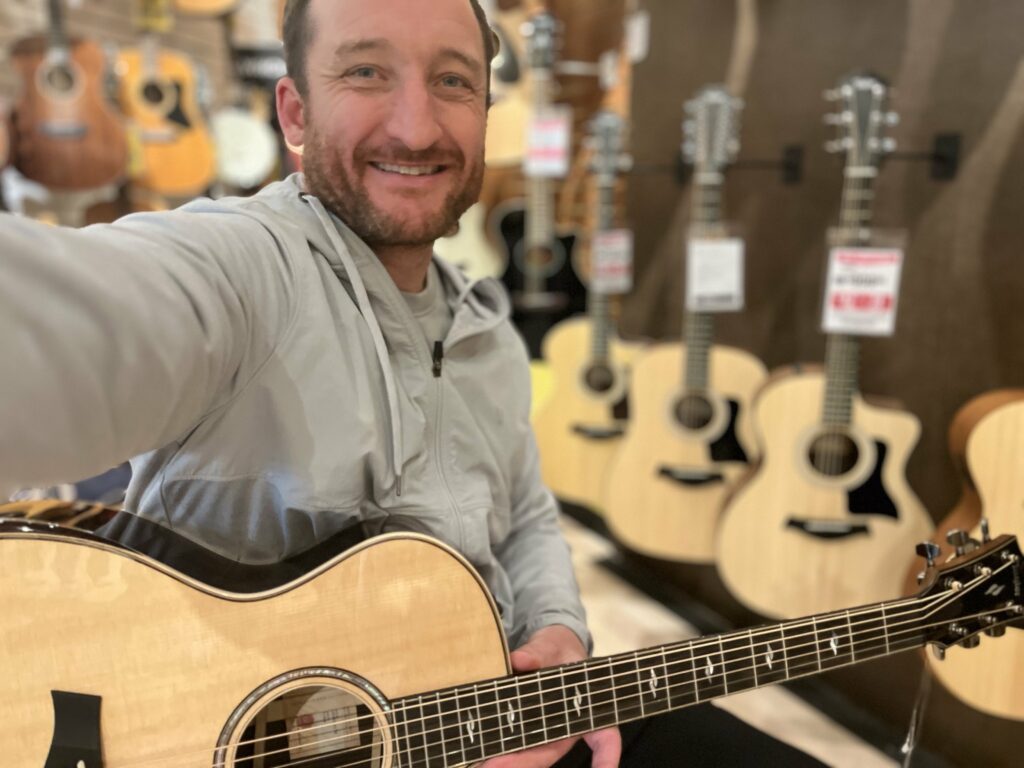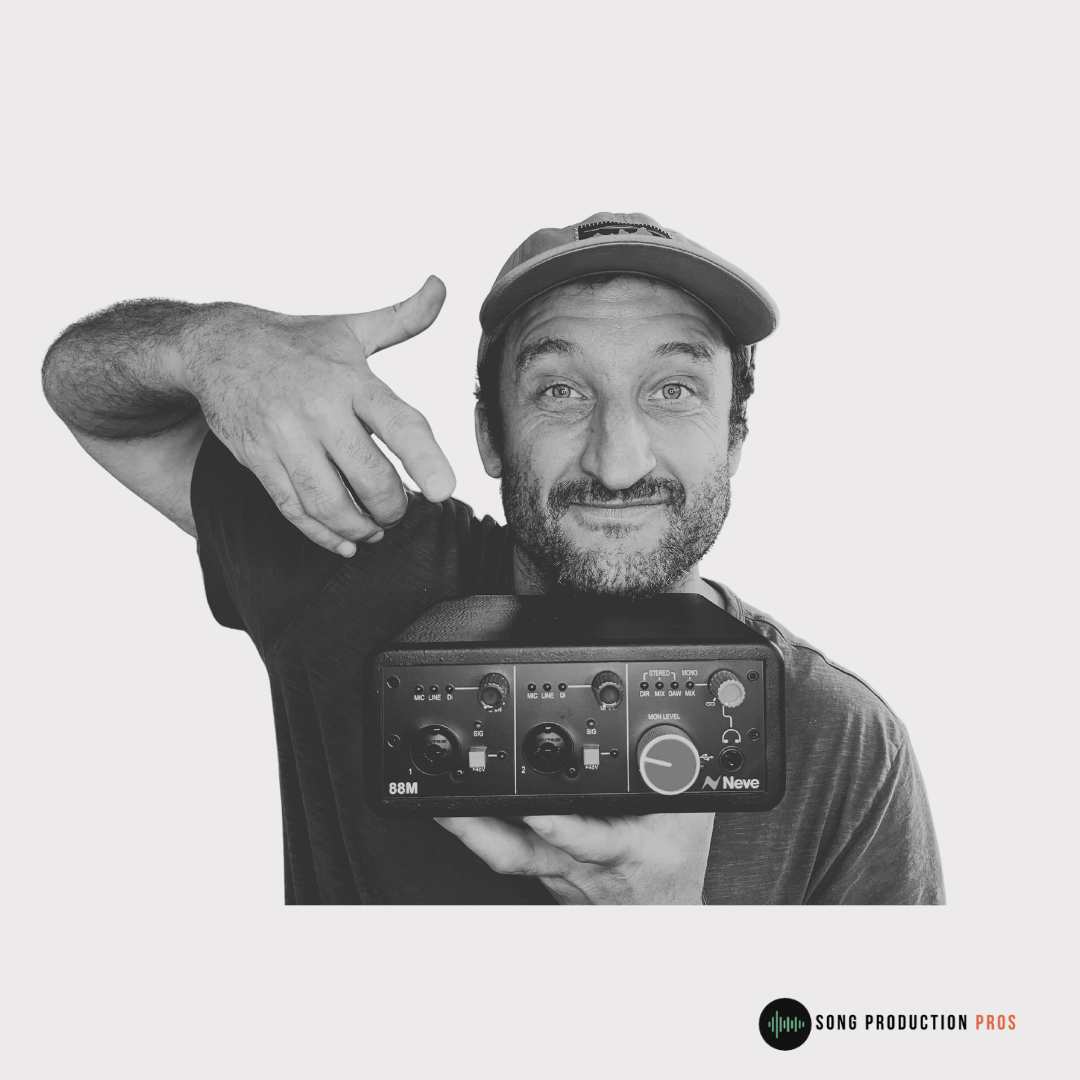
If you’ve been scouring the internet for a comprehensive Neve 88m review, your search ends here. Dive into the most detailed AMS Neve 88m audio interface analysis. This compact powerhouse promises studio-grade performance right on your desktop.
Hey there, Brad Johnson here, founder and chief writer at Song Production Pros. With over 15 years of recording experience and collaborations with Grammy-nominated artists, I’ve been on a constant quest for the best gear. Today, we’re peeling back the layers of the Neve 88m, a device that’s been generating waves in the audio community.
As we navigate the core of this Neve audio interface, here’s a roadmap of our journey ahead:
- Unveiling the Neve 88M: What is this audio titan, and what arsenal does it bring to the table?
- The Sonic Palette: Evaluating its auditory signature across varied recording canvases.
- The Ideal Suitors: Understanding its niche—those it serenades and those it doesn’t.
- The Competitive Landscape: How does it hold up against stalwarts like the Universal Audio Twin X?
- Virtues & Nuances: A balanced assessment of its strengths and considerations.
- The Final Note: My seasoned verdict and recommendation on this piece of tech.
At a Glance: The Neve 88M Audio Interface
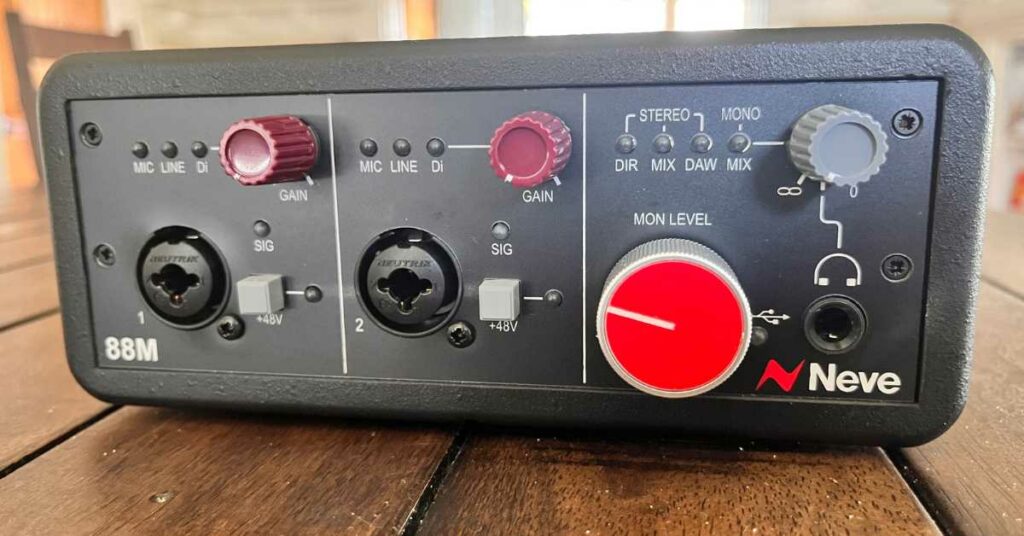
Before we deep dive, here’s a quick summation of my hands-on experience:
- The Sonic Brilliance: Its AD/DA converters deliver an open, dynamic, and intricate auditory experience.
- Analog Magic: The preamps are nothing short of mesmerizing. They breathe an analog life into recordings—making them lively, authentic, and profoundly detailed.
- The Sweet Spot: This interface is a dream for those yearning for the majesty of a pro studio console encapsulated in a portable audio interface.
- A Caveat: It might not be the best buddy for the ones who lean towards the “fix it in the mix” philosophy, seeking versatility and many features.
- The Letdown: The headphone output was a tad disappointing, emitting sounds that felt muted, constrained, and tinted.
- Tactile Feedback: The knobs, albeit functional, gave a plasticky feel—a touch more sturdiness would have been appreciated.
Stay with me as we unravel this intricate tapestry, thread by thread.
Table of Contents
History of the Neve 88R Recording Console
When you think of Rupert Neve, you don’t just think of a brand or a man but a journey. A journey that began with an insatiable hunger for audio excellence. The Neve name rapidly became synonymous with impeccable sound quality in the professional audio industry. Its significance stretches beyond equipment—it’s a chapter in music history that embodies unmatched audio brilliance.
From Neve’s earliest innovations in the 1960s to the modern-day marvels, the evolution of their consoles has mirrored the growing needs of the industry. Among these legends, the Neve 88R shines brilliantly, epitomizing the Neve console’s storied past and innovative future.
Think of the Neve 88R as a masterpiece. It’s where the heart and soul of classic Neve Console design meets today’s most advanced technology. Artists and engineers don’t just use the 88R—it becomes a part of their sound, creating sonic masterpieces.
Why the Adoration for the 88R?
- Sonic Prowess:The 88R doesn’t just record sound; it captures the essence of music. Imagine peering through a crystal-clear window pane—that’s the level of clarity we’re talking about. Be it the soft strumming of an acoustic guitar or the vibrant energy of EDM, the console never misses a beat.
- Warmth & Color: Beyond the technicalities, music is emotion. The 88R’s mic preamps signature Marinair-branded input transformers aren’t mere components; they’re artisans sculpting sound with warmth, depth, and that unique Neve color.
- Reliability & Versatility: From London to LA, world-class studios bank on the 88R. Its adaptability across genres and trustworthiness during those intensive recording hours is legendary.
A Console Celebrated by the Greats
The 88R’s influence isn’t restricted to technical circles. Musical legends have showered accolades on this iconic console:
- Sir George Martin: “Neve consoles are the ‘Rolls Royce’ of the industry. You’ve got to do the right thing by your business. You’ve got to buy the right console at the right price. When it comes down to it, the Neve has the edge on any other.”
- Roy Thomas Baker: “The new Neve 88R at the Village gave me the sound and integrity associated with vintage 1066 and 1081s while providing the convenience, ergonomics, and reliability of a modern desk.”
- Jeff Greenberg: “The sound of the 88RS is unbelievable. It is the best-sounding desk we have ever heard. It’s a beautifully engineered, exquisitely manufactured piece of gear.”
For those yearning for the legendary 88R essence in a compact package, meet the Neve 88M Audio Interface. This mini powerhouse promises to bring that iconic Neve magic to your home studio setup. Ready to embark on your own Neve journey?
Of course! Here’s an attempt to bridge the two tones, aiming to retain a touch of the original’s descriptive depth while maintaining clarity and conciseness:
Certainly! Here’s the edited section:
The Neve 88R Preamp: Stepping into the Spotlight
While I’ve consistently praised the Universal Audio Apollo Series for its impeccable blend of analog and digital capabilities, I recently found myself drawn to the entirely analog Neve 88M Audio Interface. I compared the 88M against the 88RS Unison Preamp in my Apollo Twin X to thoroughly assess its prowess.
Recording Vocals with a Condenser Microphone
Upon connecting a condenser microphone to the 88M, I immediately noticed the vocals’ clarity and presence. They weren’t merely audible—they had a distinct liveliness. The interface ensured a crisp high-end, which smartly managed sibilance. At the same time, the lows remained pronounced without veering into excessive depths.
One key feature I must highlight is the interface’s input transformers. They don’t just enhance the audio; they give it fullness, lending vocals a more textured and engaging sound. When lined up against the Universal Audio Apollo Twin X with its 88RS Unison-Enabled capabilities, both interfaces shone in distinct ways, showcasing their unique audio profiles.
Sound Examples:
Recording Acoustic Guitar with a Condenser Microphone
For acoustic guitar recordings, the Neve 88M Audio Interface delivered a balanced warmth and brightness of sound. Those familiar input transformers added a touch of character, subtly enhancing the guitar’s inherent tones. When matched with the Universal Audio Apollo Twin X equipped with the 88RS Unison preamp, the 88M preamp circuit offered a hint of more brilliance. However, the distinctions were not overwhelmingly dramatic.
Sound Examples:
Recording Electric Guitar: Direct Input & Using the Strymon Iridium Amp & IR Cab Simulator
Modern recording techniques emphasize the importance of a reliable DI inputs for electric guitars, especially with the rise of amp and cab simulators like the Strymon Iridium. Using the Neve 88M Audio Interface in this setting, its capacity to capture the depth and details of an electric guitar became evident. The low-noise floor and the line inputs transformers’ transformative touch ensured a sharp and rich sound.
When paired with tools like the Strymon Iridium, the Neve 88M stood out. The clarity and richness it provided contrasted with Apollo, which occasionally felt a shade muted.
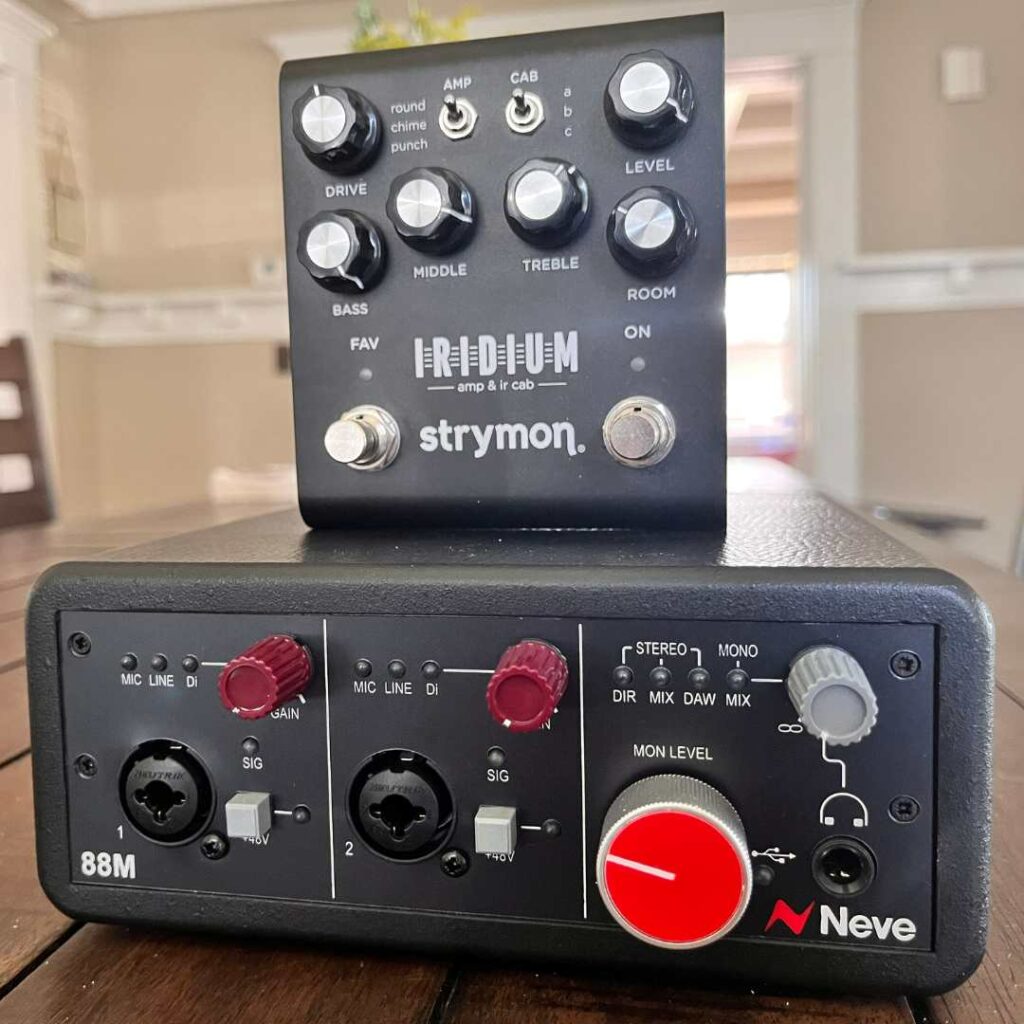
Sound Examples
Marinair Transformers: The Heart and Soul of Neve
When diving into the Neve universe, it’s impossible to ignore the pivotal role of Marinair transformers. These aren’t just your average components; they represent the distinctive sonic signature that has made Neve stand out for decades.
Developed exclusively for Neve, Marinair transformers are more than just tools for electrical conversion. They have a unique way of processing the audio that goes through them. When a signal travels through these transformers, it’s subtly shaped and refined, adding a richness and depth that’s hard to replicate. Think of them as a trusted old guitar – adding character and color to the music each time it’s played.
These transformers are known to introduce a controlled level of harmonic distortion. Now, before you balk at the word ‘distortion,’ certain types of distortion can be your ally in the world of audio recording. In the case of Marinair transformers, this distortion enriches the sound, making it warmer and more textured.
Furthermore, the Marinair transformers excel in two essential technical areas: impedance matching and common-mode rejection. Impedance matching ensures that devices connected in a recording setup can ‘talk’ to each other without any signal degradation. On the other hand, common-mode rejection is all about reducing the noise that might creep in from inputs or external sources. These dual functions mean that not only does your audio sound richer with the Marinair touch, but it’s also clearer without the pesky interference you’d want to avoid.
In a nutshell, when working with the Neve 88M, you’re not just using a piece of recording equipment. You’re tapping into a legacy of audio excellence, where every note you record carries the weight and warmth of Neve’s storied history.
The Shortcomings of the Neve 88M
Every piece of equipment, even those that are iconic and revered, comes with its limitations, and the Neve 88M is no exception. While it carries the Neve name with pride and distinction, here are some areas where it could do better:
- Phase Switch Absence: An apparent oversight is the missing phase switch. It’s an invaluable feature when you’re capturing sound in stereo and need to ensure the phase relationship is spot-on. Its omission is noticeable, but it’s not a game-changer for many.
- Input Pad: The Neve 88M USB audio interface could benefit from an integrated input pad, especially when interfacing with high-output microphones or pickups. Without this, users might find themselves wrestling with unexpectedly high gain levels.
- Harnessing the Marinair Transformer: To fully exploit the sonic capabilities of the Marinair transformer’s saturation, you must route through an external compressor via the send and return. While this transformer’s character is a significant draw, needing additional gear to get the best out of the unit is not ideal.
A Deep Dive into the Neve 88 M’s Design and Functionality
A Nod to Heritage
The Neve 88M Audio Interface doesn’t just wear its lineage; it parades it with aplomb. Draped in a Tolex-style covering over a solid metal framework, the 88M evokes memories of the iconic Neve consoles, taking you on a trip down memory lane. The embossed Neve logo isn’t just a mark; it’s a testament to the pedigree of craftsmanship the brand represents.
While most of its build screams quality, a few quirks pop up. The knobs, while functional, lack a certain gravitas in their material quality. Their plastic feel doesn’t match the overall premium aura the device exudes.
From an ergonomic standpoint, the frontal positioning of the mic inputs and DI input jacks is a double-edged sword. On the one hand, it facilitates quick and hassle-free mic access. Conversely, it’s a tad inconvenient for maintaining a clutter-free desk space, with cables jutting out prominently.
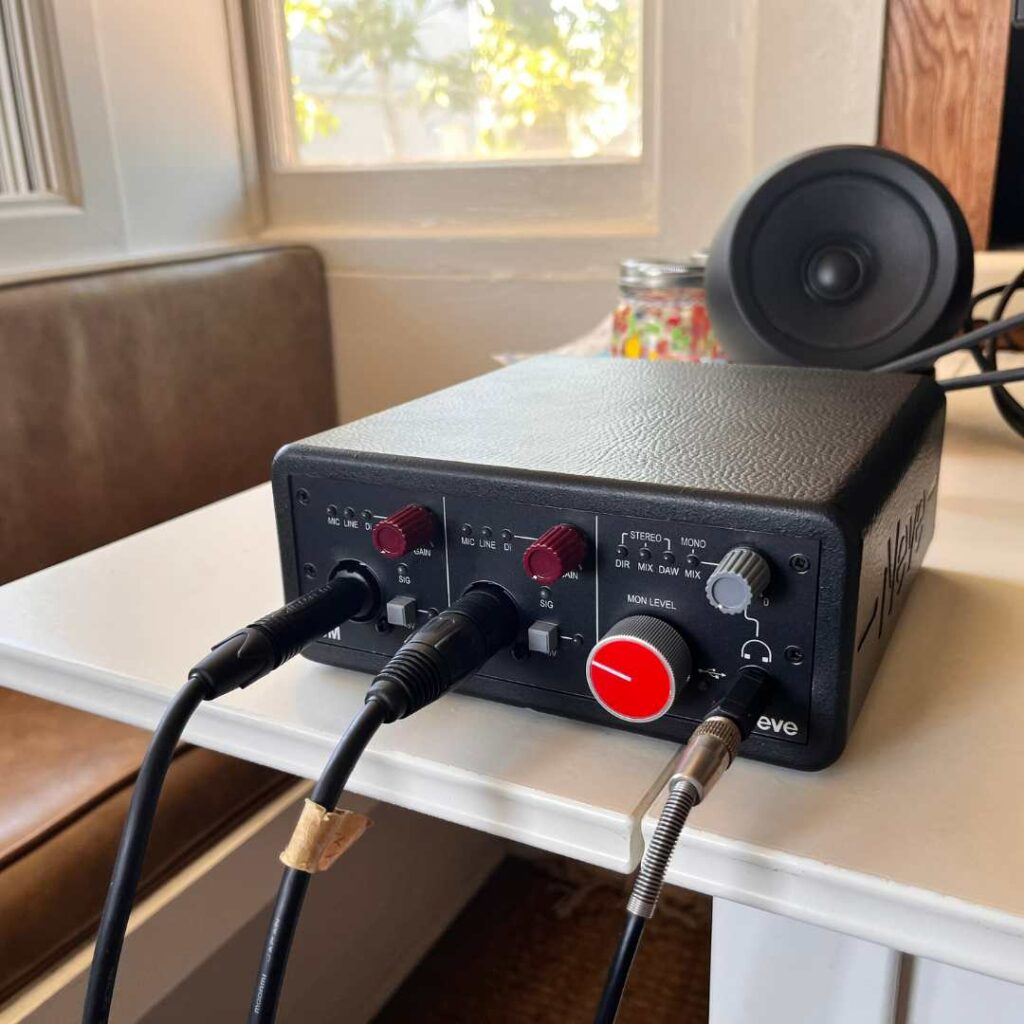
In the Realm of Conversion
Central to any audio interface is its AD/DA conversion capabilities. The Neve 88M boasts conversion chips that genuinely uphold the gold standard. Pinning it against formidable competitors like the Universal Audio Apollo Twin X, the 88M’s conversion feels more vibrant, maintaining unparalleled clarity and dynamism. It’s not an outright dismissal of the Apollo Twin X but more of an accolade to the 88 M’s prowess in preserving sonic integrity.
The Headphone Amp: A Mixed Bag
The headphone amplifier on the 88M is practical, offering four distinct monitoring modes to cater to varied needs. Its standout feature is the no-latency monitoring during recording, a significant advantage for artists who desire instant feedback.
Yet, it’s not without its challenges. Users might notice the headphone output inclining toward compression, with a hint of distortion. This could be an area of concern for professionals who rely heavily on headphone mixing.
Monitor Outputs
The monitoring domain of the 88M is a reflection of its professional lineage. Its dynamic range and max output levels stand testimony to its stellar specs. The zero-latency mic input and monitoring is a boon for real-time recording. However, its mono summing feature, restricted to the headphone output, is a slight blemish for those keen on a comprehensive mono mix experience.
Sends and Returns
The 88M USB audio interface stands out in its approach to connectivity, especially for those who swear by outboard equipment. Including TRS balanced inserts, the 88M allows for patching in outboard gear after the preamp section and before the converters. This is a true rarity in audio interfaces.
This consideration is a nod to those seeking tonal depth and perfection, making the 88M a unique asset in analog recording and modern audio interfaces.
Scalability at Its Best
One can’t help but appreciate the 88M’s foresight in terms of expansion. The interface’s ADAT digital expansion capabilities, allowing the addition of digital outputs for multiple channels, are a godsend for studios aspiring to grow without compromising on quality.
Simplified Power Supply
With USB Bus-power and devoid of cumbersome external power units, the AMS Neve 88M USB audio interface shines in its portability. Whether on-location recordings or pristine studio setups, it’s a fuss-free companion.
Compatibility Across the Board
No fiddly setups for Mac users; the 88M effortlessly integrates as a Core Audio device. Windows 10 users would require a quick driver setup, but it’s smooth sailing past that.
Deciphering the Perfect Match: Who is the Neve 88m Made For?
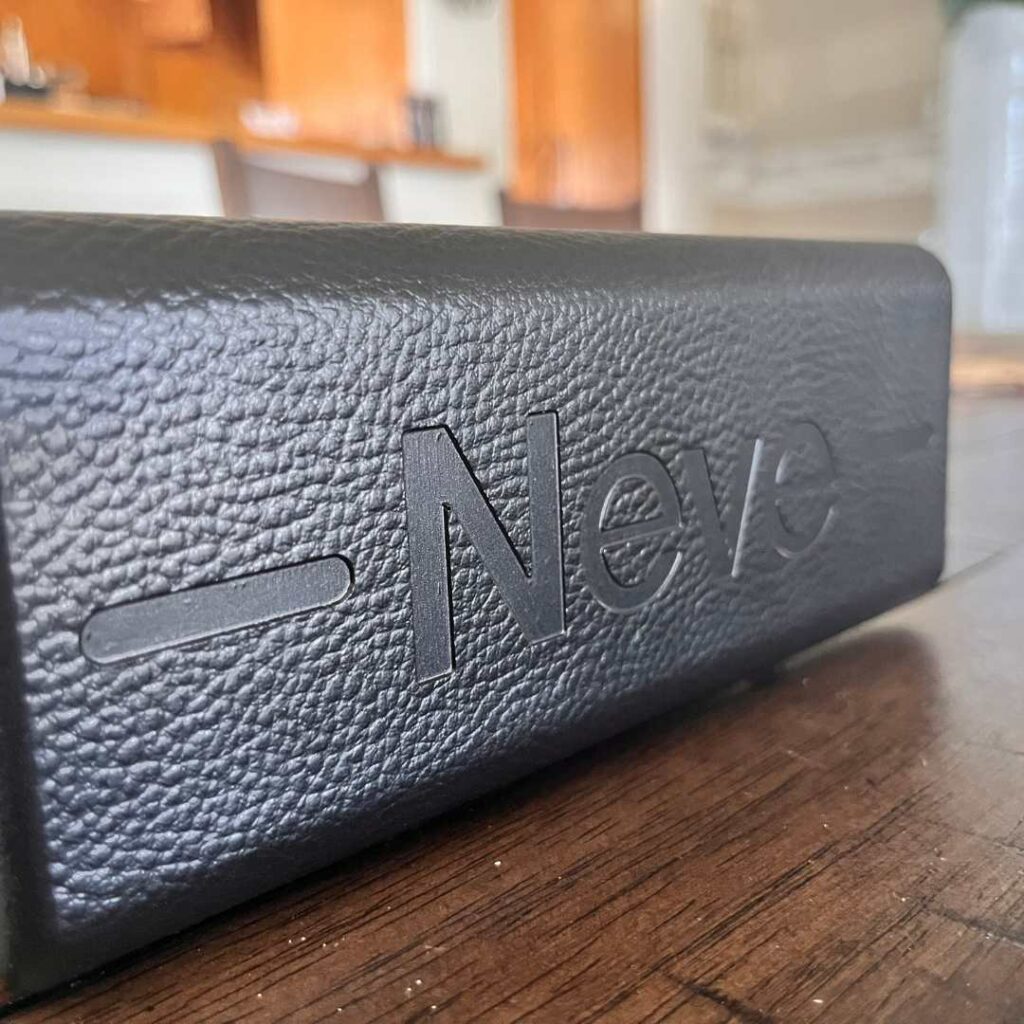
1. The Home Studio Craftsperson
The Neve 88m shines brightest for those seeking to inject classic legacy into their modern home studio setup. Here’s the rundown:
- Chasing the Analog Dream: Compact setups no longer mean settling for less. With the 88m, a rich tapestry of vintage textures is now within reach of any bedroom producer. Those two AMS Neve preamps and Marinair transformers are the stuff of legends.
- Uncomplicated Yet Refined: Gone are the days when achieving a professional sound required a manual’s worth of troubleshooting. The 88m paves a direct path to excellence without unnecessary detours.
- Compact Might: Size can be misleading. With its stellar AD/DA conversion, the 88m holds its own against more bulky counterparts, offering premium sound quality, low-latency monitoring, and expansion capabilities via ADAT.
- Financial Commitment: Craftsmanship comes at a cost. The 88m is undeniably a superior interface. Still, its pricing might pause budget-conscious enthusiasts, especially when comparing feature-to-feature with other home studio recording packages.
2. The Roaming Sound Architect
The ever-moving producer or sound engineer finds a reliable companion in the Neve 88m:
- Designed for the Journey: Every aspect of the 88m, from its sturdy chassis to the protective Tolex finish, speaks to its readiness for adventure. And for added security, the Kensington lock slot has your back.
- Anywhere, Anytime: Power outlets can be scarce treasures on the road. The 88 m’s USB bus-powered design means recording doesn’t have to wait. Its rich feature set ensures adaptability, no matter where inspiration strikes.
- Welcoming the External Ensemble: Beyond its intrinsic qualities, the 88m stands out with its unique send and return setup. It is a crucial feature for producers who regularly lean on external outboard gear to create their signature sounds.
Tackling the Most Asked Questions
What’s the role of transformers in shaping sound?
Audio transformers, often found in high-quality audio equipment, significantly influence how sound is captured and reproduced. Here’s a glimpse:
Harmonic Enrichment: Push a transformer, and it responds by adding harmonics, sometimes enhancing warmth and depth. However, this can also skew higher frequencies.
The Edge of Saturation: Beyond a point, transformers saturate, compressing the signal. Some love this for the perceived smoothness; others might find it veering into unwanted distortion territory.
Selective Hearing: Transformers can be picky about frequencies. Various design elements cause specific frequencies to be accentuated or subdued. Depending on the desired sound profile, this can be both a boon and a bane.
How do the 1073 and 88R stand apart?
Both iconic in their own right, the 1073 and the 88R are Neve’s stellar offerings but from different timelines and with distinct sonic personalities:
1073: Birthed in 1970, the 1073 became synonymous with the golden age of recording. The transformers and unique EQ profile became the secret sauce for countless hits, adding warmth and punch.
88R: A 21st-century creation, the 88R heralded a new era of clarity and precision. Its versatile EQ bands and impeccable transformers made it the go-to for audiophiles seeking uncolored, pristine sound.
Weighing the Merits: The Neve 88M Audio Interface at a Glance
Every piece of gear carves its space in the vast landscape of audio equipment. The AMS Neve 88M is no exception. While it dazzles in many areas, it has its nuances. As a potential user, understanding its highlights and potential drawbacks is paramount. Drawing from many user experiences, let’s break down its virtues and considerations.
Strengths
- Empowered Mobility: The Neve 88M deftly fuses power with portability. Its bus-powered architecture removes the hassle of additional power units, ensuring swift setups and takedowns.
- The Neve Legacy: The legendary Neve preamps, paired with Marinair transformers, aren’t just parts; they’re sonic storytellers. Conjuring the essence of celebrated records, they offer unparalleled sonic richness and fidelity.
- Precision in Conversion: The Neve 88M stands firm as a bastion of audio authenticity. Its stellar AD/DA conversion faithfully captures and reproduces every nuance.
- Incorporating Analog Heritage: Outboard equipment finds a seamless ally in the Neve 88M. Its send and return provision is a nod to old-school audio processing, promoting a fusion of classic and contemporary.
- Future-ready Design: The ADAT expansion capability ensures the Neve 88M grows with your aspirations, making it an evergreen addition to any studio.
- Uncluttered and Intuitive: The AMS Neve 88M USB audio interface, with its uncomplicated design, welcomes both novices and veterans, amplifying creativity while minimizing technical barriers.
Considerations
- Restrained Connectivity: The Neve 88 M’s I/O options might seem constrained for multifaceted recording setups or expansive sessions.
- DSP or Mixer Software Void: The absence of inbuilt DSP or mixer software is outside the DNA of the analog-inspired Neve 88M. However, these features are popular in modern audio interfaces and maybe something to consider if you want a more feature-rich box.
- USB 3.0 Dependency: Being tethered to a USB 3.0 host port might curtail its compatibility, especially with older systems or devices still in the USB 2.0 era.
- Premium Investment: The Neve 88 M’s price reflects its elite features. However, this investment might stretch the budget for beginners or casual enthusiasts.
- Lacking Preamp Flexibilities: The absence of a polarity switch or pad for the preamps can occasionally tether creativity, especially in nuanced recording scenarios where phase or attenuation fine-tuning is pivotal.
My Final Thoughts
At the heart of the Neve 88M audio interface are its two 88RS preamps, carrying a legacy of warmth, depth, and unmatched clarity that’s become synonymous with Neve. Supercharged by the iconic Marinair transformers, these preamps become the central attraction, instantly elevating any recording session.
If this resonates with your audio needs, check out the Neve 88M at Sweetwater.com. Sweetwater was gracious enough to send me a unit for this review. Even though they sponsored this content, my commitment to genuine, unbiased reviews remains unwavering.
Your perfect sonic partner is a click away!

